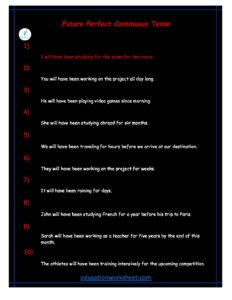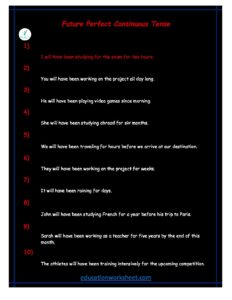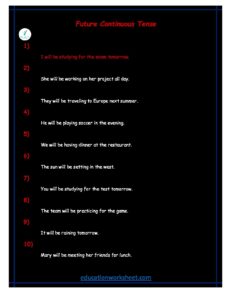how to converting Future Continuous Tense negative sentences to positive form
how to converting Future Continuous Tense negative sentences to positive form
Tenses are an essential part of English grammar, helping us express actions and events in different time frames. One of these tenses is the Future Continuous Tense, which is used to indicate actions that will be ongoing at a specific point in the future. Understanding how to convert negative sentences in the Future Continuous Tense to their positive forms is a valuable skill for effective communication. In this comprehensive guide, we will delve into the Future Continuous Tense, explore its structure, and learn how to transform negative sentences into positive ones.
Future Continuous Tense:

A Brief Overview The Future Continuous Tense, also known as the Future Progressive Tense, is used to describe actions that will be in progress at a certain time in the future. It is typically constructed using the auxiliary verb “will” or “shall” (for the future) and the base form of the main verb, followed by “be” and the present participle (the “-ing” form of the verb).
Let’s look at the basic structure of positive Future Continuous Tense sentences:
- [Subject] + [will/shall] + [be] + [verb+ing] + [rest of the sentence]
For example:
- I will be studying tomorrow.
- She will be working late tonight.
- They will be playing football at 5 PM.
Now, let’s explore the process of converting negative sentences in the Future Continuous Tense to their positive counterparts.
Converting Negative to Positive:

Step by Step Converting negative sentences to positive in the Future Continuous Tense involves changing the sentence’s meaning from a denial of action to an affirmation. To achieve this transformation, follow these steps:
Step 1: Identify the Negative Sentence Begin by identifying the negative sentence in the Future Continuous Tense. Negative sentences typically include the word “not” after the auxiliary verb “will” or “shall.”
For example:
- I will not be studying tomorrow.
- She will not be working late tonight.
- They will not be playing football at 5 PM.
Step 2: Remove the “Not” The key to converting a negative sentence to a positive one is to remove the word “not.” This simple action reverses the sentence’s meaning from negative to positive.
For example:
- I will be studying tomorrow.
- She will be working late tonight.
- They will be playing football at 5 PM.
Step 3: Ensure Proper Subject-Verb Agreement Ensure that the subject and verb in the sentence agree in number. The subject should match the form of the verb (singular or plural) used in the positive sentence.
For example:
- I will be studying tomorrow. (The subject “I” agrees with the singular verb “will be.”)
- She will be working late tonight. (The subject “She” agrees with the singular verb “will be.”)
- They will be playing football at 5 PM. (The subject “They” agrees with the plural verb “will be.”)
Step 4: Maintain Verb Tense and Timing Ensure that the verb tense and timing remain consistent with the original sentence. The action should still take place in the future.
For example:
- I will be studying tomorrow. (The action of studying is still in the future.)
- She will be working late tonight. (The action of working is still in the future.)
- They will be playing football at 5 PM. (The action of playing football is still in the future.)
Step 5: Check for Agreement in the Rest of the Sentence Review the rest of the sentence to ensure that it aligns with the positive form. Other elements in the sentence, such as time adverbs or objects, should remain unchanged.
For example:
- I will be studying tomorrow. (The time adverb “tomorrow” remains the same.)
- She will be working late tonight. (The time adverb “tonight” remains the same.)
- They will be playing football at 5 PM. (The time adverb “at 5 PM” remains the same.)
By following these steps, you can successfully convert negative sentences in the Future Continuous Tense to their positive counterparts while preserving the tense, subject-verb agreement, timing, and other elements of the sentence.
Common Pitfalls and Challenges Converting negative sentences to positive ones in the Future Continuous Tense is generally straightforward, but there are some common pitfalls and challenges to be aware of:
- Double Negatives: Be cautious of double negatives. In English, using two negatives in the same sentence usually intensifies the negation. For instance, “I will not not be studying tomorrow” is not a standard construction.
- Subject-Verb Agreement: Pay close attention to subject-verb agreement. Ensure that the subject and verb match in number and that the verb tense remains appropriate for the future.
- Time Adverbs: When converting negative sentences to positive, time adverbs or other elements in the sentence should remain unchanged to ensure the sentence’s meaning and context are preserved.
Practice Exercises To reinforce your understanding of converting negative sentences in the Future Continuous Tense to positive forms, try the following practice exercises:
Exercise 1: Convert the following negative sentences to positive sentences:
- She will not be watching a movie this evening.
- They will not be cooking dinner tomorrow.
- I will not be attending the conference next week.
Exercise 2: Create original sentences in the Future Continuous Tense, both positive and negative, using the following subjects and verbs: Subjects: He, we, it Verbs: singing, studying, traveling
Exercise 3: Write sentences that describe what you or someone you know will be doing at a specific time in the future using the Future Continuous Tense. Make sure to include both positive and negative forms.
Additional Tips and Resources
- Consistency: Maintain consistency in your use of tenses and sentence structure to ensure clear and effective communication.
- Grammar Guides: Consult reliable grammar guides and textbooks for in-depth explanations and examples of various tenses, including the Future Continuous Tense.
- Practice: Regular practice is crucial for mastering tenses and their transformations. Engage in exercises, quizzes, and writing to reinforce your skills.
how to converting Future Continuous Tense negative sentences to positive form

In conclusion, converting negative sentences to positive ones in the Future Continuous Tense is a fundamental aspect of English grammar. By following the steps outlined in this guide, you can effectively change the meaning of a sentence from negation to affirmation while maintaining proper subject-verb agreement, tense, timing, and other sentence elements. With practice and a solid understanding of this tense, you’ll be better equipped to express future actions clearly and accurately in English.

